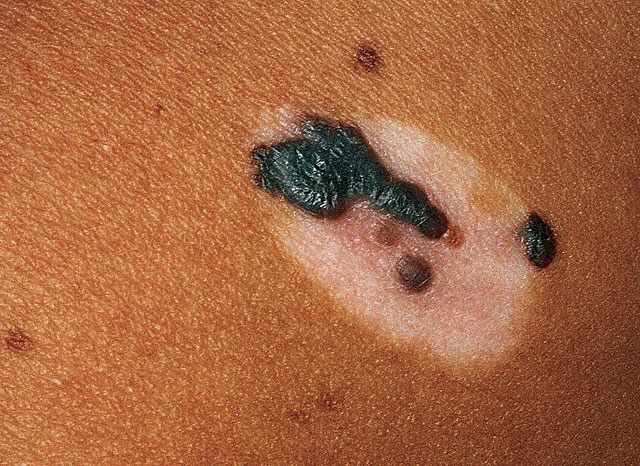Melanoma is a kind of skin cancer. It is not as common as other types of skin cancer, but it is the most serious.
Melanoma can affect your skin only, or it may spread to your organs and bones. Luckily, it can be cured if it’s found and treated early.
What causes melanoma?
You can get melanoma by spending too much time in the sun. This causes normal skin cells to become abnormal. These abnormal cells quickly grow out of control and attack the tissues around them.
Melanoma tends to run in families. Other things in your family background can increase your chances of getting the disease. For example, you may have abnormal, or atypical, moles. Atypical moles may fade into the skin and have a flat part that is level with the skin. They may be smooth or slightly scaly, or they may look rough and “pebbly.” These moles don't cause cancer by themselves. But having many of them is a sign that melanoma may run in your family.
What are the symptoms?
The main sign of melanoma is a change in a mole or other skin growth, such as a birthmark. Any change in the shape, size Click here to see an illustration., or color Click here to see an illustration. of a mole may be a sign of melanoma.
Melanoma may grow in a mole or birthmark that you already have. But melanomas usually grow in unmarked skin. They can be found anywhere on your body. Most of the time, they are on the upper back in men and women and on the legs of women.
Melanoma looks like a flat, brown or black mole that has uneven edges Click here to see an illustration.. Melanomas usually have an irregular or asymmetrical shape. This means that one half of the mole doesn't match the other half. Melanoma moles or marks can be 6 mm (0.25 in.) or larger.
Unlike a normal mole or mark, a melanoma can:
- Change color.
- Be lumpy or rounded.
- Become crusty, ooze, or bleed.
Your doctor will check your skin to look for melanoma. If your doctor thinks you have melanoma, he or she will remove a sample of tissue from the area around the melanoma (biopsy). Another doctor, called a pathologist, will look at the tissue to check for cancer cells.
If your biopsy shows melanoma, you may need to have more tests to find out if it has spread to your lymph nodes.
How is it treated?
The most common treatment is surgery to remove the melanoma. That is all the treatment that you may need for early-stage melanomas that have not spread to other parts of your body.
Depending on where the melanoma is on your body, and how thick it is, the surgery to remove it may leave a scar. You might need another surgery to repair this scar.
After surgery, your doctor will want to see you every 3 to 6 months for the next 5 years. During these visits, your doctor will check to see if the cancer has returned and if you have any new melanomas.
If your melanoma is very deep or has spread to your lymph nodes, you may need medicine called interferon to fight the cancer cells.
Can you prevent melanoma?
The best way to prevent all kinds of skin cancer, including melanoma, is to protect yourself whenever you are out in the sun. It’s important to avoid exposure to the sun’s ultraviolet (UV) rays.
- Try to stay out of the sun during the middle of the day (from 10 a.m. to 4 p.m.).
- Wear protective clothes when you are outside, such as a hat that shades your face, a long-sleeved shirt, and long pants.
- Get in the habit of using sunscreen every day. Your sunscreen should have an SPF of least 15. Look for a sunscreen that protects against both types of UV radiation in the sun's rays—UVA and UVB.
- Use a higher SPF when you are at higher elevations.
- Avoid sunbathing and tanning salons.
Check your skin every month for odd marks, moles, or sores that will not heal. Pay extra attention to areas that get a lot of sun, such as your hands, arms, and back. Ask your doctor to check your skin during regular physical exams or at least once a year. Even though the biggest cause of melanoma is spending too much time in the sun, it can be found on parts of your body that never see the sun.



 Admin on
Admin on  11:25 PM
11:25 PM















0 komentar:
Post a Comment